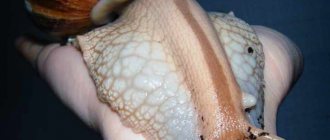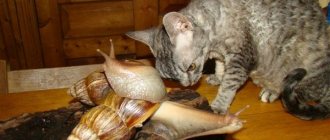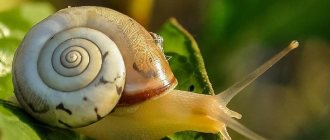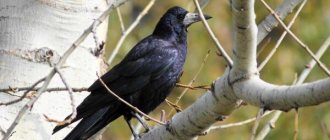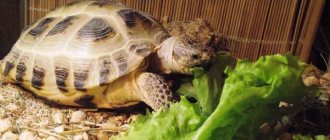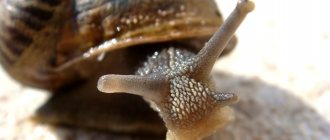The average life expectancy of snails at home depends on a complex of external factors. To properly care for a pet, its habits and food preferences are studied. Knowledge of anatomy helps to ensure proper care and health care for the mollusk.
- 1 Snail in nature
- 2 What determines the lifespan of snails
- 3 Mr. Tail recommends: life expectancy of snails by species 3.1 Aquatic
- 3.2 Land
- 3.3 Others
Snail - description and characteristics
The snail's body consists of a head, legs, visceral sac, and mantle fold. The mollusk moves on the sole, which covers the lower part of the leg. This process is the result of muscle contractions that create a kind of wave. To make sliding as comfortable as possible, the epithelium of the limb secretes a lot of mucus.
Small snails can move by beating their cilia.
The internal sac is located inside the shell in the form of a spiral or cap. The mantle of snails that live in water contains gills. This organ must be constantly washed by a stream of water, to organize this process, the mantle is equipped with:
- an inlet siphon through which the liquid enters;
- an outlet siphon through which water is removed.
Also inside the mantle are:
- kidney ducts;
- excretory system;
- intestines;
- reproductive apparatus;
- lung (for those living on land).
There is a special hole for air to enter the breathing organs. It is located on the edge of the shell or on the front side of the body.
The head consists of:
- stalks with eyes;
- tentacles (organ of touch);
- oral cavity.
Sink
The shell of a snail, like other mollusks, consists of several layers:
- Periostracum is a thin layer covering the outside of the structure. It consists of a protein - conchiolin.
- Ostracum is a calcium carbonate middle layer wrapped in conchiolin.
- Hypostracum (mother-of-pearl) – a layer located inside. It consists of calcium carbonate plates coated with conchiolin.
The shell is an integral part of the snail's body. The external skeleton of a mollusk protects it from enemies, external negative factors, and retains moisture.
A snail is born with a shell, only in babies it is thin and transparent.
The shape of the external skeleton: conical, in which all the organs of the mollusk are located asymmetrically, or flat spiral. Surface – smooth or with growths. The turns in the spiral are located from left to right, but there are very rare cases when it is the other way around. Dimensions and colors can vary.
Some snails have a reduced shell - a calcareous plate inside the mantle. These are mainly slugs, which can be found in any garden.
Teeth
Representatives of gastropods are distinguished by a special organ in the oral cavity - the radula. This organ performs the functions of the tongue and teeth. The radula consists of a cartilaginous plate on which there are several rows of teeth of different shapes.
Vegetarian snails have small teeth, predators have large ones in the shape of a pike or hook. The number of teeth in a snail can reach 25,000. Basically, the radula includes 120 rows, each with 100 teeth = 12,000.
Poisonous snails generally have teeth with a cavity through which poison flows from a special gland, paralyzing the victim.
Snails live in nature and feed on animal food. These species are distinguished by drill-shaped teeth. It can drill into the oyster's shell or other hard protective shells, which helps the mollusk get to the meat.
Snail slime
Clam mucus is a composition that is very important for the snail. It consists of a complex protein (mucin) and water.
The unique properties of this substance are today widely used in cosmetology as an anti-aging, sunscreen, and moisturizer.
Mucin regulates mineralization processes and shell creation. Mucus is divided into two types:
- The first type helps the mollusk move by moisturizing the surface.
- The second type is produced by a special gland, as a response to any stress and mechanical damage to the shell. The main components of such mucus are polysaccharides and mineral salts, which have restorative and regenerating properties.
Family dish of snails
We could only eat half of this dish from last year’s snails - it was too filling.
Of course, before completing the description of the dish, I first went online using the key combination of words “grape snails recipe” and naturally did not find the one that BMP used to sculpt the delicacy. And no wonder - 45 years of experience gleaned from a whole shelf of cookery books dating back almost to Stalin’s times + 15 years on the Internet and in at least 10 TV kitchen programs in all languages. But that’s not all – grape snails are only one of several components of the delicacy. An equally important component of the dish – mushrooms – were brought from the forest.
In appearance, julienne from BMP does not look pompous, like the snail shells themselves from pictures on the Internet, but the taste simply cannot be conveyed - you have to try it!
So, let's start with the ingredients, and they are mainly from the forest - on all sides surrounding the summer cottages. You and I have already walked in and around our summer cottages - while collecting grape snails at the end of April. Now, in about three minutes, we’ll drive a few hundred meters along forest roads – that’s all. The BMP had already mowed down what was closer. And in just a couple of hours, the two of us will collect so many different mushrooms that we can only deliver them to the dacha with the help of our iron horses.
Now I’ll tell you briefly and see how we put the spoils of a quiet hunt in order. Unlike milk mushrooms and milk mushrooms, after cleaning the needles and other forest debris and removing the film from the caps, we immediately boil the butter milk mushrooms for 20 minutes in their own juice - tuzuluk. Saffron milk caps do not give as much juice as boletus, so boil them for 5 minutes in boletus juice. After decanting the juice through a colander, put it in liter boxes and freeze.
Experienced mushroom pickers know that, for example, almost half of butter mushrooms can go to waste, which our “ Angels of the Earth ” happily fly away and naturally not in its pure form, but with a larger amount of “garnish”, which is cardboard, waste paper and leaves .
However, without dwelling on the great benefits of mushrooms, snails and pistachios, it’s still time for you and me to return to consistency - grape snails are a recipe for preparing a forest culinary delight - the snail-mushroom-pistachio julienne that was uneaten yesterday. And I’m undernourished, because it’s such a rich dish - we can’t eat more than 100 grams at a time. There used to be times that we could even eat kebabs all day on Sunday with dry wine, but now we can’t handle a tablespoon of low-calorie dietary snail fillet.
Where does a snail live in the wild?
The snail lives in all climatic conditions on all continents, except Antarctica and arid deserts. The mollusk lives in the warm waters of the Pacific Ocean, the Mediterranean and in the cold environment of the Arctic Ocean and the Barents Sea.
Snails feel great in Europe, Africa, Australia, and America. It is found in Asia and Russia. The main condition for the existence of a mollusk is high humidity, which will not allow the snail’s body to dry out, otherwise the animal may die.
What does a snail eat?
Everything a snail eats depends on its habitat. The nutrition of the mollusk is surprising in its diversity, it can be:
- the soft part of fresh plants.
- plant remains;
- small relatives;
- worms;
- carrion;
- fish;
- insects;
- crustaceans.
Land mollusks happily eat leaves, berries, fruits, vegetables, bark, and grass. Young ones prefer fresher food, but with age their preferences change, and the old snail begins to feed on rotten plants.
Some species eat flies, midges, mosquitoes, and carrion. A rotten tree can be a delicacy for a street snail.
In order to grind food well, the mollusk's teeth require calcium. Its deficiency leads to the fact that the snail begins to sharpen its shell, which collapses, leaving the body without protection. This leads to dehydration and death.
You can feed snails in an aquarium:
- fish food;
- aquarium plants;
- algae tablets;
- chopped vegetables.
To ensure that the aquarium is not left without all vegetation, it is best to take control of the number of mollusks. A moderate amount of snails is good for the algae as it eats up all the rot on it and cleans the aquarium. It is also recommended to grind eggshells in a coffee grinder to replenish calcium in the body of gastropods.
It is worth monitoring your pet’s diet; he should not be given human food. You also need to put newspapers away, because the snail eats them with great pleasure, but rarely survives after such a feast.
You can include the diet:
- plantain;
- legumes;
- cucumbers, zucchini, pumpkin, tomatoes, bell peppers;
- greenery;
- dandelions;
- bananas, watermelon, pears, strawberries, apples.
For land representatives, do not forget to put a bowl of clean water.
What affects life expectancy
Each type of snail has its own characteristics that affect their life span. However, Achatina, ampularia, and the grape snail, and their other brethren will live longer if:
- feed them correctly (moreover, Achatina quickly gets used to some food and then reluctantly switches to another, so it is important to alternate food more often);
- do not warm up the air in the terrarium to avoid sudden temperature changes);
- provide the snails with calcium carbonate (egg shells and chalk are suitable);
- maintain the required level of humidity for land snails in their home;
- place aquarium juvenile snails in a separate container so that they are not eaten by fish;
- control the number of snails so that they do not begin to die of hunger;
- cover the aquarium with a lid or a special mesh so that snails (for example, ampullaria) do not get out;
- Do not feed your pet snails salty food, salt is poison for them.
Snail breeding
Gastropods in most cases are oviparous animals. The process of fertilization and egg laying depends on the snail’s habitat.
Snails with lungs, living in fresh waters and on land, are hermaphrodites. Such mollusks have both female and male sexual characteristics. In this connection, during mating, cross-fertilization occurs.
Freshwater snails lay eggs in capsules, and land snails lay eggs in dug holes. The mollusk can lay up to 85 pieces at a time. Eggs mature within 28 days and can have different colors:
- transparent;
- green;
- white;
- pink.
The development of this snail takes place without stages of transformation. Having passed the required period of maturation, a fully formed individual with a transparent shell is born, which hardens over time and acquires its own color.
Snails with gills are heterosexual creatures. Males are endowed with a testis and a vas deferens. Female mollusks have an ovary and an oviduct.
Eggs are laid in a special cocoon with a lid, which dissolves as the larvae develop. For the safety of future offspring, the outer row of eggs is not filled, this allows the predator to be left without lunch.
The development of gastropods occurs with transformations from an egg into a larva (veliger). With the help of outgrowths with thin cilia, it moves and feeds on small particles of food of plant and protein origin. After a few days, the mollusk forms and sinks to the bottom.
There are unique species of gill snails that do not lay eggs but go through a gestation cycle. The embryo remains in the mother's body until it is fully mature and only then is it born.
Snail diseases
Snails may suffer from the following diseases:
- Broken sink, holes, cracks. In this case, the animal should receive the maximum amount of calcium, rest, high humidity and the right temperature.
- Shell lamination. This process can occur against the background of improper maintenance, stress, and poor heredity.
- White plaque on the sink. The problem arises against the backdrop of poor conditions, such as age-related changes, or it could be simple abrasion.
- Burns. They can be thermal or chemical. In this case, the snail hides in its shell and hardly moves. You can alleviate the condition by increasing humidity and increasing the amount of juicy vegetables and fruits in your diet.
- Poisoning. Occurs due to poor quality nutrition.
- Self-chewing. The snail begins to eat itself due to calcium deficiency, stress or heredity.
- Organ prolapse.
Diseases, prevention and treatment
Mollusks are quite sensitive and do not have strong immunity and strong health, so you will have to protect your pet from possible illnesses and diseases by properly caring for snails.
- Overheat. When overheated, clams lack body fluids and are unable to produce enough mucus to protect the body.
- Hypothermia. Due to their constantly wet body, mollusks are especially prone to hypothermia.
- Hypovitaminosis. Occurs when there is a lack of any vitamin in the mollusk’s diet. Calcium deficiency is especially dangerous. Calcium is necessary for the construction of the shell and if it is deficient, any chipping will become a serious problem. For treatment, diversify your diet with dandelion leaves and flowers, and provide constant access to calcium. Pets also need protein supplements (gammarus, daphnia), which should be added to the diet a pinch 1-2 times a week.
- Shell injuries. Small fragments of the shell will still grow back, but if the pet has completely lost the shell, then it becomes non-viable. Infections and fungal diseases lead to shell loss.
- Parasites, worms. They enter the body from poor-quality food, soil or non-compliance with hygiene rules. For treatment, you will need antiparasitic or anthelmintic agents, as well as a complete replacement or treatment of the soil (boiling or calcining in the oven).
Prevention
Follow the rules of hygiene: wash your hands before contacting your pet with plain water without using chemicals, promptly clean the container or terrarium from mucus and food waste. Prevent food from rotting and choose healthy foods.
The best prevention is proper care, timely cleaning of the terrarium and complete treatment or replacement of the soil every six months.
Enemies in the wild
Gastropods are among the most invisible organisms on earth. But despite this, the individual has enough enemies:
- sea gobies;
- sardine;
- sea stars;
- mackerel;
- whales;
- herring;
- hermit crabs.
For land snails, the following are dangerous:
- moles;
- blackbirds;
- wild boars;
- lizards;
- hedgehogs
Freshwater mollusks should be afraid of:
- trout;
- storks;
- frogs;
- herons.
Snails are slow and careful, which helps them protect themselves from enemies. They avoid highly lit areas and stay deep in the substrate.
How long does a snail live? Lifespan
Snails have good stress resistance, but do not live more than 25 years. In nature, the mollusk is exposed to constant dangers, which significantly shorten the life of gastropods.
For example, grape snails can live 20 years, but most often their life span does not exceed 8 years.
In captivity, a snail lives as long as it was initially given. The main thing for this is to follow all the rules of keeping and feed your pet correctly.
Interesting facts and useful tips
Various stories about mollusks can be found on the Internet:
- The record for life expectancy belongs to the Grape Snail. The pet was 30 years old at the time of its death.
- The red reel can float on the surface of the water. When she gets scared, she lets out the air and falls like a stone to the bottom.
- Land species are big fans of warm showers. They are held underwater in the palm of your hand. Particles of household chemicals remain on the surface of plumbing fixtures, which can kill your pet.
- Giant snails get used to their owner and are even able to determine his position in the room.
- Not a single case of allergy caused by shellfish has been recorded. Mucus is a good wound healer.
- Animals can go without food for a long time. During fasting, they fall into suspended animation and use up the body's internal reserve.
Types of snails
The snail has more than 110,000 species, the habitat of 2,000 of them is the territory of Russia.
The most poisonous gastropod is the Geographical Cone, living in the Pacific and Indian Oceans. It produces enough toxins to kill ten people. An antidote to the poison of this mollusk has not yet been found.
The poisonous snail affects its enemies by releasing a cloud with high levels of insulin, which instantly lowers the victim's blood sugar level.
The smallest mollusk is Angustopila dominikae. Its size is 0.8 mm. For example: 4 such snails can easily fit in the eye of a needle.
The Australian trumpeter is recognized as the largest gastropod. The giant snail weighs 18 kg. It belongs to the class of predators, lives at a depth of 30 m in the coastal region of Australia, New Guinea, Indonesia and eats worms.
Snails are divided according to their place of residence into:
- marine;
- land;
- freshwater
There are pulmonary and gill.
Grape snail
A large-sized land snail whose habitat is the European part of our continent. The shell of this species is 50 mm, spirally curved in 5 turns.
The length of the leg is from 35 to 52 mm, and the width is 22 mm.
Color ranges from cream to brown with a red tint. The first 3 turns along the entire diameter alternate with light and dark stripes. Small ribs are clearly visible on the outside of the shell. In the wild, the mollusk lives from 8 to 20 years.
In winter, the snail is at rest for three months, attaching its sole to the substrate and clogging the shell with special mucus. During wintering, the snail loses up to 10% of its weight. After activation, the mollusk recovers within a month and a half.
The grape snail can tolerate low temperatures down to -7°C, but not more than 10 hours.
The grape snail has been bred at home for a long time. Today, special snail farms are opening in some countries.
Gastropod meat consists of:
- 15% - protein;
- 8% - carbohydrates;
- 35% fat.
It also contains a number of essential minerals and vitamins.
The grape snail is a delicacy, and in Europe it is eaten as a complete, healthy product. It is also bred for use in cosmetology and the pharmaceutical industry.
The grape snail is bred at home in special terrariums, instead of other exotic, but not always safe animals. Mollusks are hermaphrodites, therefore, for breeding, it is enough to have heterosexual individuals of sexual maturity.
At home, the grape snail feeds on plant foods. They can be fed vegetables and fruits. The gastropod has a good appetite, so you need to make sure that it always has food.
The grape snail is kept at home in a glass or plastic jar or box with good ventilation and a large bottom.
You can prepare the clam as follows:
- 100 pieces. gastropods;
- 1 liter of white wine;
- 2 carrots;
- 800 g special snail oil;
- 200 g vinegar 3%;
- 2 onions;
- thyme, salt, parsley to taste;
- Bay leaf;
- 3 tbsp. flour.
The snails are poured with cold water and, after boiling, cooked for about 7 minutes. It is washed, dried, the shell is removed, and the black tip is cut off. The finished product is poured with white wine with the same amount of water, chopped vegetables, seasonings and herbs are added. Salt in a proportion of 10 g per 1 liter. Cook for 3.5 – 4.5 hours, then leave to cool. The sinks are thoroughly washed in a weak soda solution and rinsed in running clean water.
Sauce or special oil for shellfish: 100 grams of grated onion + 2 cloves of chopped garlic + parsley + salt, ground black pepper + 800 g of softened butter. Stir thoroughly.
The shell is filled with the prepared oil and the prepared snail and heated in the oven before serving.
Snail coil
Gastropod coil is a freshwater snail that lives in bodies of water with lush vegetation and a slight current. The mollusk survives even in very polluted waters with minimal oxygen content.
The shell is a tightly twisted spiral of several turns with a seam visible to the naked eye. This type of snail is currently common among aquarium holders, in which the mollusk grows up to 1 cm; in the wild, the size of a gastropod can reach 3.7 cm.
Color - from brick color to deep red. The gastropod can move its shell down along the surface of the water with the help of air accumulated inside. Sensing danger, the snail releases the remaining oxygen and falls to the bottom.
The coils are:
- horny;
- horny red;
- Far Eastern;
- keeled;
- wrapped.
The coil cleans the aquarium well, eating rotten parts of plants and food residues.
garden snail
Garden gastropod is a big pest in garden plots, which their owners actively fight against. The snail happily eats fresh crops and spoils young leaves and shoots, sometimes causing irreparable harm.
But there are also benefits from these shellfish. They process the remains of vegetation, acting as orderlies.
The garden snail does not have any features that distinguish it from other relatives. She lives on the ground, hiding in the shadows during the day and emerging from it in the evening for food.
This mollusk is not whimsical and is very often kept in aquariums at home. This is the most economical option for breeding snails. The garden snail does not require special care and eats everything that grows in the garden.
Neretina snail
A mollusk called neretina is one of the most popular aquarium snail species. The bright, variegated color is individual for each individual and is not repeated, making each gastropod exclusive. Keeping such an animal is not difficult.
The Neretina snail grows up to 3.2 cm, has a flat oval (round) shell, decorated with various patterns with a beautiful, noticeable color. The body of the mollusk is large and dark in color.
The Neretina snail is divided into four types:
- zebra – striped color;
- brindle - orange and black stripes;
- olive – color similar to the name;
- horned - the head is characterized by horns and mustaches.
The mollusk was born in Africa, where it lives in all available bodies of water. Neretina is not whimsical; it easily survives for a certain period without feeding, eating waste from other inhabitants of the aquarium and rot on the walls.
To prevent the mollusk from getting burned, it is recommended to keep the aquarium away from direct exposure to ultraviolet radiation and select lighting with minimal power.
At home, the snail should be periodically pampered with calcium supplements. You can also include chopped vegetables, fish food in powder form, and ground chicken egg shells in your diet.
Achatina giant
For a long time, the mollusk was distributed only on the African continent, but today this snail is often found as a pet.
Achatina giant is distinguished by the largest shell size, which can reach 20 cm and weigh up to 0.5 kg. The mollusk does not survive in the natural conditions of Russia; here it is kept at home in special terrariums.
The Achatina shell of the specimen has a conical shape, twisted clockwise. The color consists of stripes of brown in different shades. There are also albinos who are completely white. The mollusk feeds on plant foods. By gender, it performs the functions of a male and a female, that is, the African snail Achatina, which is a hermaphrodite.
Makes 6 clutches per year, each of which can produce 200 eggs. Achatina lives for about 7 years, but with proper care this figure can increase to 10.
The African snail Achatina prefers to sleep during the day and stay awake at night. If you increase the humidity in the aquarium, the mollusk will become active during daylight hours.
Helena snail
The Helena mollusk is a freshwater species native to Southeast Asia. Gastropods do not have a very good reputation, since they periodically eat their relatives. Aquarium owners most often keep this species of gastropod to exterminate other snails.
Helena has a positive attitude towards running water, but at the same time they do well in artificial reservoirs, lakes and aquariums. The substrate chosen is sand or silt.
The individual feeds on live snails and carrion. The shell is conical with pronounced irregularities, can reach 20 mm, the color is yellow with brown stripes. The body is gray-green in color. The Helena snail lives for a short time, about two years.
Keeping a gastropod at home is easy. It is best to make water harder within a pH range of 7-8 without adding salt. The mollusk prefers to burrow into soft soil, fine gravel, and sand. The offspring of a gastropod that is born does the same.
At home, gastropods feed on the same small-sized mollusks. Large individuals do not suffer, since the Helena snail cannot cope with them. The process of eating occurs with the help of a tube on which the mouth is located; it is inserted into the shell of the gastropod and sucks out the body of the gastropod. The individual also feeds on regular fish food, krill, and frozen shrimp.
Helenas are heterosexual animals and reproduce well in captivity. Mating between a male and female can last for hours; quite often other relatives join them and the created group sticks together, continuing the process. The female lays one egg, which develops very slowly.
As aquarists note, the Helena snail can seriously reduce the population of other mollusks, so the number of this individual must be controlled.
Slug
Slugs are a snail without a shell that is completely similar to its relative. Some species have a small, inconspicuous shell covered by a mantle.
Basically, the size of the mollusk does not exceed a few centimeters. But despite this, there are individuals that can reach 32 cm!
Color – gray-brown, chestnut, black, red, yellow, depending on the species. Slugs live on all continents in areas where there is high humidity. The lack of their own house forces them to seek shelter from the sun, winds, and cold.
The mollusk is active at night, when the heat subsides and gentle coolness sets in. A relative of the snail overwinters deep in the soil.
The slug moves with the help of the sole, which contracts in waves; for more comfortable sliding, a copious amount of mucus is released. In search of food, despite its slowness, the individual is ready to cover considerable distances.
Most mollusks eat plant foods. They eat everything:
- leaves;
- flowers;
- fruit;
- berries;
- mushrooms.
The slug also eats:
- carrion;
- feces;
- lichens.
Predators eat worms, their relatives, newborn mice, and hatched chicks. The feeding process occurs with the help of the radula, which is studded with teeth.
The hermaphrodite reproduces once a year; it lays up to 40 eggs. For many gardeners, a slug is a pest that must be destroyed. But it is worth noting that this mollusk has the largest male genital organ among its relatives, which after mating it can bite off in order to detach itself from its partner. Over time, the organ recovers.
Bitinia
A small freshwater mollusk with a smooth, spiral-shaped shell. Size within 15 mm. Color: brown, gray, olive. The life cycle lasts up to 5.5 years. Lives on the American and Eurasian continents.
Luzhanka
A freshwater gastropod with a blunt-conical shell up to 43 mm in length and 31 mm in width, curled in several turns. The color depends on the habitat and can be: greenish, brown, red, brown.
The Luzhanka snail is a viviparous mollusk.
Gastropods live in all regions of Europe except the northern regions.
Buccinum (trumpet player)
A large sea snail, with a shell reaching 24 cm diagonally and 17 cm vertically. Color – light brown. The surface is embossed or smooth.
The mollusk is a predator and paralyzes its prey with poisonous saliva. Lives only in northern oceans with cool water.
Ampularia
An aquarium snail that requires special conditions. This mollusk loves to eat a lot, and if there is a lack of food, it begins to spoil plants. The size of the gastropod reaches 15.5 cm.
To keep a mollusk, it is necessary to organize an air space above the water in the aquarium. This will help the snail to breathe fully. The mollusk can periodically crawl out of the aquarium, so it is better to close it, since without water it will die. Under normal conditions, ampularia can live up to 4.5 years.
Fiza
The Physa snail, measuring within 2 centimeters, is popular among experienced aquarists. The special shape of the shell helps the mollusk hide in the most secluded places.
Gastropods feed on living algae. The presence of lungs allows the body to exist without water. It is recommended to control the population of this type of snail, since it reproduces very quickly.
The mollusk is a good aquarium cleaner from plaque and bacterial films on the walls. Use hard water with a temperature of at least 21 degrees.
Tylomelania
Tilomelania is a bright mollusk that will decorate any aquarium. It requires special care, since the snail eats a lot and does not get along well with its other relatives. The length of the gastropod reaches 13 cm.
The color of the shell can be any color, the surface can be smooth or with spikes. It is best to make water for clams soft and highly acidic.
The snail needs to be fed three times a day. She is not picky about food, loves a lot of light, and requires a lot of space.
Melania
The Melania clam is an aquarium snail that reproduces quickly and instantly cleans the aquarium of waste. Gastropod feels comfortable in water with a temperature of 17 to 29 °C. Color – gray-green. Conical shell. Melania is an omnivore.
Pagoda (brothia)
This mollusk requires sufficient oxygen in the water and prefers sand in the form of soil. It feeds on algae and fish food. The pagoda has a very short lifespan - only six months.
Marisa
The large mollusk Mariza is unpretentious in food, it does not require complex care, and it has the ability to rise to the surface of the water and breathe air. Mariza feeds on algae and aquarium fish food.
Introduction
If we consider snails as pets, one of the most important questions is their life expectancy. Experts say that on average this figure is 15 years. Not bad. But this is an average, taking into account all the existing diversity of these amazing representatives of wildlife. There are species of snails that can live 25, 30 years. For others, the “age” will be only a year or two. Keeping them at home can, oddly enough, extend these periods, because captivity also has its advantages: balanced nutrition, protection from predators and natural disasters.
Keeping a snail at home
Caring for and maintaining shellfish at home requires certain conditions. For the snail to live, you need to prepare:
- terrarium;
- Plastic container;
- aquarium;
- house for rodents.
- The container for a mollusk, in the worst case, should not be less than 10 liters per individual, in the best - 20 liters.
- To prevent your pet from running away, you need to make sure the lid is tight.
- To allow oxygen to enter, it is recommended to make several holes in the lid.
- You should pay more attention to the height of the aquarium than to its width.
- It is best to hide snail housing from bright light, and electric lighting can be excluded.
- The soil can be: soil for flowers; peat; coconut substrate; tree bark; sawdust.
- Comfortable water temperature in the aquarium for snails is +25° – +30°.
- For land mollusks, it is necessary to periodically treat their place of residence with fresh water from a spray bottle to maintain normal humidity.
- Don’t forget to put drinking water in a small container and change it constantly.
- If you do not care for the mollusk correctly, it may die or go into hibernation.
- The terrarium must be kept clean regularly.
Proper feeding of a snail is the key to its health and the ability to live as long as the snail lives in the best possible conditions.
Arrangement of the terrarium
How to care for garden snails in captivity? First of all, they need soil to hide in if necessary. The humidity of the substrate should be such that no water comes out when pressing on it.
It is better to use soil from the place where the snail was taken. The layer of soil not treated with pesticides should be sufficient for the mollusk to burrow completely into it.
Flower soil is not suitable for creating a terrarium substrate. It contains chemical additives that are harmful to shellfish.
Sphagnum moss, vermiculite, compost or peat work well as a soil covering. They absorb and retain moisture well, which prevents the substrate from drying out. Such conditions for keeping garden snails are as close to natural as possible, which contributes to their normal life.
An untreated snag or branch placed in a terrarium will greatly help a garden snail feel “at home.” The mollusk will always be able to find shelter under it if it senses danger. He also likes to hide in damp fallen leaves and spends most of his time in such a “shelter”.
Useful properties of snail
A snail is not just a resident of an aquarium or a pest in the garden; the mollusk has many useful properties that people have learned to use as efficiently as possible.
- Snail meat is very healthy and in many countries it is prepared as a regular dish.
- Mollusk mucus is distinguished by a large number of biologically active substances:
- elastin;
- amino acids;
- collagen;
- vitamins;
- natural antibiotics;
- allantoin.
- The protein content in shellfish meat is one and a half times higher than in a chicken egg.
- Snail meat is recommended for dietary purposes.
- Shellfish does not cause allergies.
- In ancient times, snails were actively used for therapeutic purposes.
- In modern medicine, mollusk mucus is used to treat silicosis, bronchitis, and whooping cough. Since the special composition has the property of gluing cells with bacteria. Our grandmothers would sit a snail on a piece of lump sugar and wait for it to become covered with mucus, after which they would give it to the patient to eat.
- The mucus content of the snail allows it to independently restore its shell.
- In cosmetology, ordinary mucus has become the basis for many anti-aging, regenerating, antioxidant products.
- Snails are also used to make effective masks.
- Mucus-based drugs are used to combat stretch marks, acne, scars, warts, and age spots.
Care
In order not to create unsanitary conditions in the terrarium, it should be cleaned daily of mollusk waste. At the same time, his feces and uneaten food are removed to prevent them from rotting.
- The soil in the container should be replaced at least once a month. The terrarium is cleaned with a damp sponge, which will help free its bottom and walls from dried mucus and other traces of the presence of a mollusk.
- You need to systematically moisten the container with snails using a spray bottle. There is no need to place a separate container of water in the aquarium.
- Moistening the top layer of the substrate (moss, peat, fallen leaves, etc.) will help maintain the required level of soil moisture. A moistened substrate is very important for the garden snail.
- Grape and garden snails, as well as chain snails, do not require additional heating of the terrarium. They require periodic changes in dry and humid climates, as happens in nature.
- If the air temperature is too low, the clams will need a warming mat. At the same time, they will need to be hibernated at least for a short time in winter so as not to disturb the natural biological rhythm. This will increase the lifespan of the garden snail.
How long do garden snails live in captivity? With proper care, they last a very long time, and they actively reproduce.
But those who want to add wild mollusks to their homes should take into account that they can be carriers of various infections, including those dangerous to humans.
4.4 / 5 ( 9 votes)
